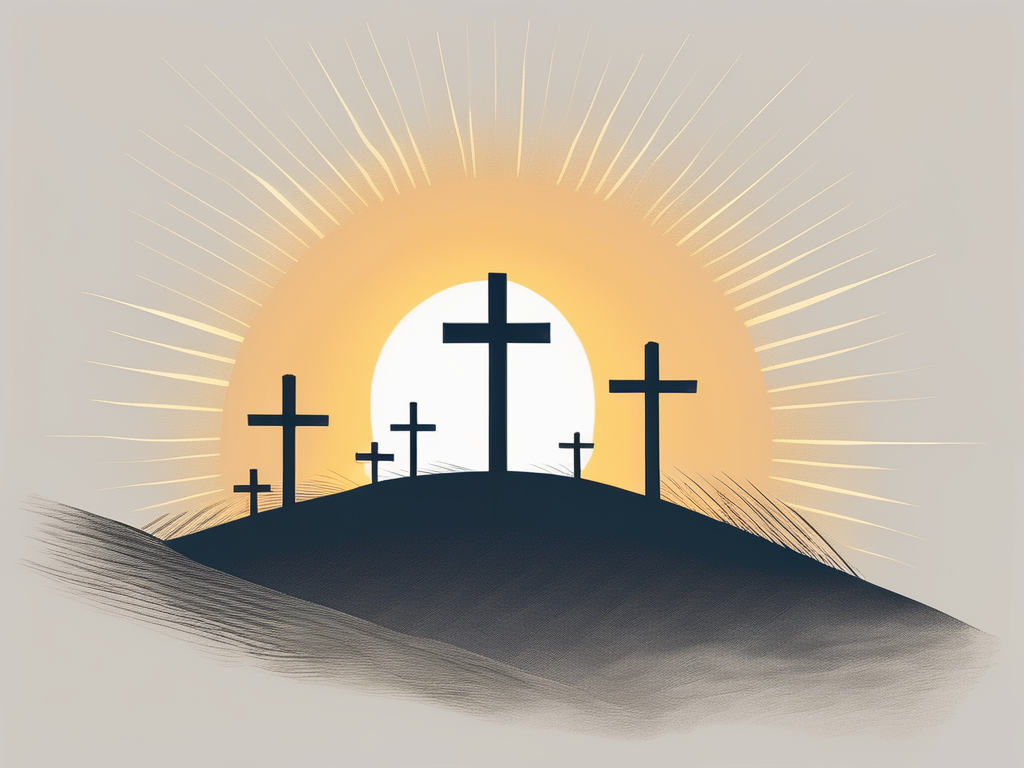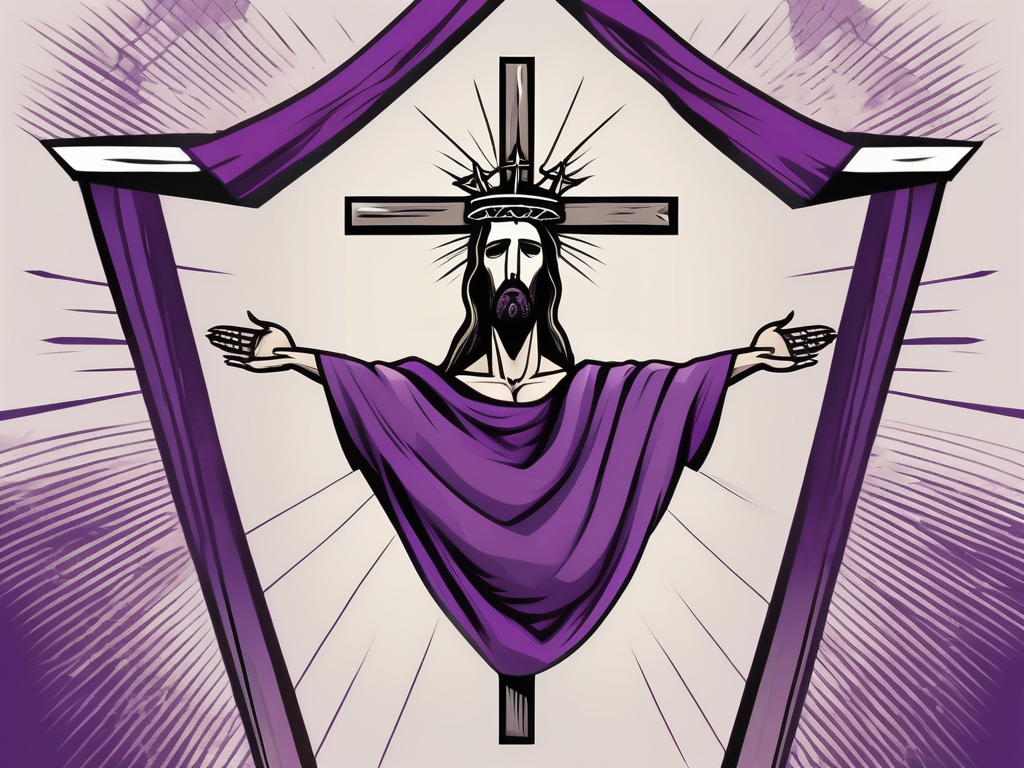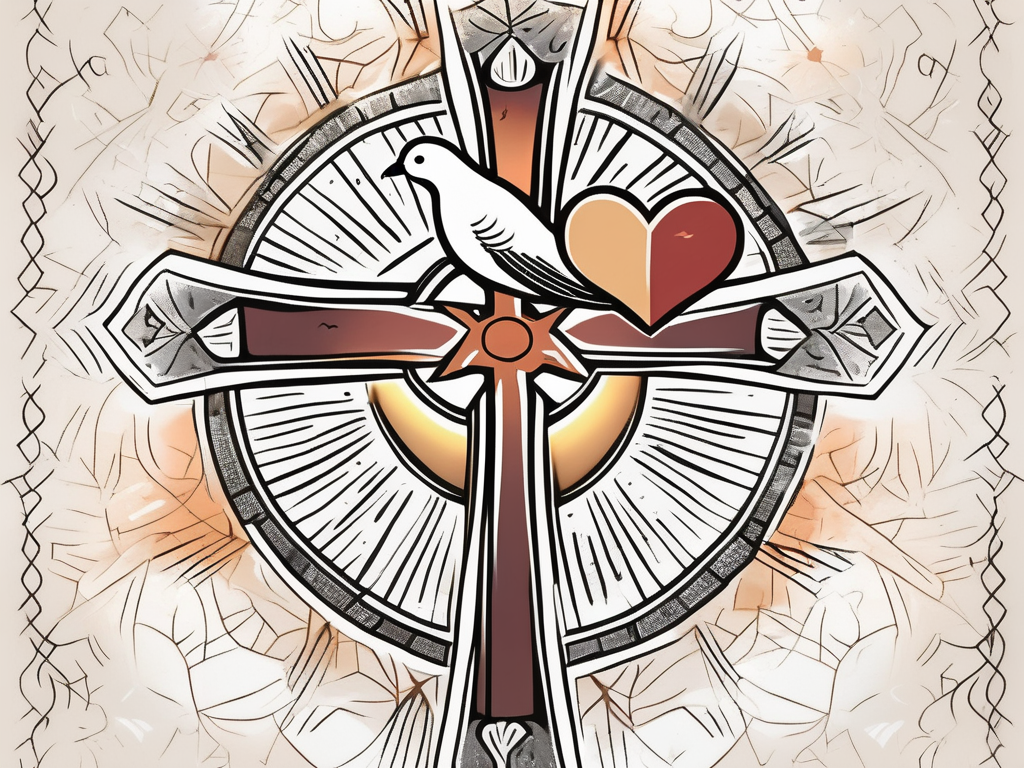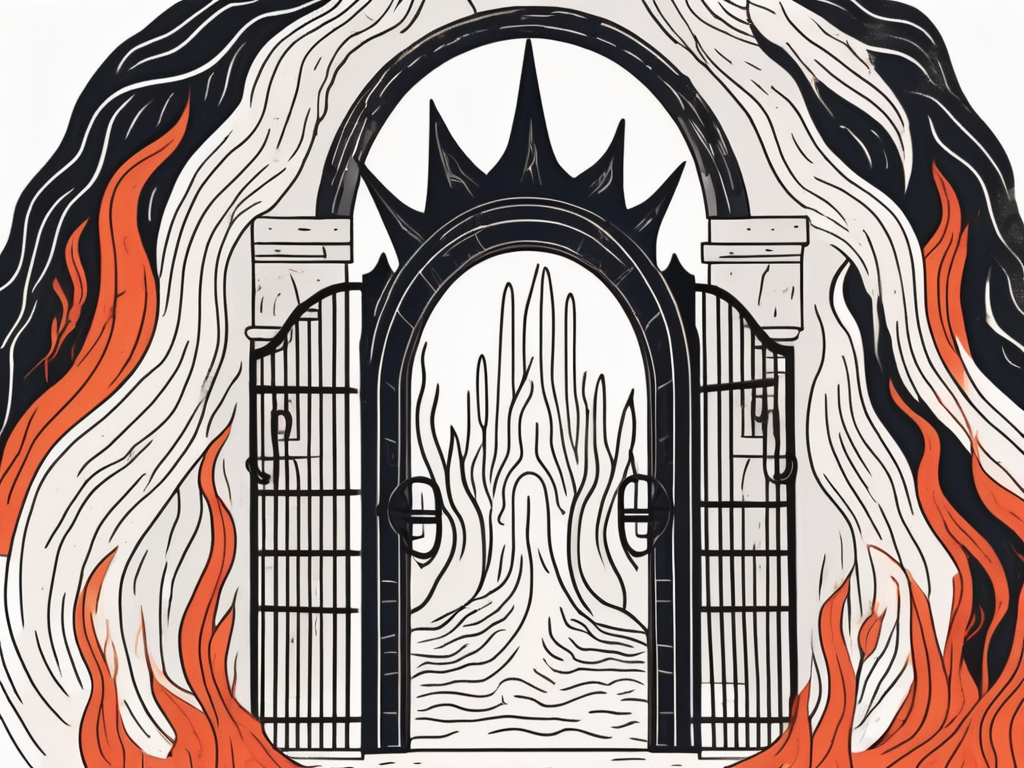The crucifixion of Jesus Christ is one of the most significant events in human history. In this article, we will dive deep into the biblical story, understanding its historical context, exploring the theological significance, examining debates and controversies, and analyzing its portrayal in art and culture. Through this journey, we hope to shed light on the crucifixion and unravel its profound impact on humanity.
Understanding the Historical Context of Crucifixion
Crucifixion, as a method of execution, was widely used by the Romans during the time of Jesus. It was a brutal and agonizing form of punishment, reserved for the worst criminals and rebels against the Empire. To comprehend the crucifixion of Jesus, we must familiarize ourselves with the Roman Empire and the socio-political climate of Jerusalem.
The Roman Empire and Crucifixion
At the time of Jesus’ crucifixion, the Roman Empire stretched across vast territories, encompassing diverse cultures and religions. The Romans were known for their efficient governance and military might, which allowed them to maintain control over their vast empire. Crucifixion was a tool of enforcing Roman authority, used as a deterrent against rebellion.
The practice of crucifixion involved nailing or tying the condemned person to a wooden cross, where they would hang until they died from exhaustion, asphyxiation, or shock. It was a public spectacle, often taking place in highly visible locations such as main roads or hills, serving as a gruesome reminder of the consequences of challenging Roman rule.
The crucified bodies displayed prominently served as a warning to potential troublemakers, reminding them of the fate that awaited those who dared to defy the might of the Roman Empire. The sight of a crucifixion was meant to instill fear and submission, reinforcing the power dynamics between the Romans and their subjects.
The Socio-Political Climate of Jerusalem
Jerusalem, a city teeming with religious fervor and political tension, played a crucial role in shaping the events leading to Jesus’ crucifixion. The region was under Roman rule, but it was also a center of Jewish religious and cultural identity.
The Jewish leaders, fearing Jesus’ growing influence and challenging teachings, perceived him as a threat to their religious authority. They saw him as a potential disruptor of the delicate balance between the Jewish community and the Roman occupiers. Within this volatile context, Jesus became entangled in a web of political and religious maneuverings.
The socio-political climate of Jerusalem during Jesus’ time was characterized by a complex interplay of power dynamics. The Jewish religious leaders, known as the Sanhedrin, held significant influence over the local population. They were responsible for maintaining order and ensuring the compliance of the Jewish community with both religious and Roman laws.
However, the Roman authorities also exerted their control over Jerusalem, with a governor appointed to oversee the region. This governor, Pontius Pilate, had the final say in matters of law and order, often making decisions that would appease both the Jewish leaders and the Roman Empire.
Jesus’ teachings and actions challenged the status quo, attracting a large following and causing concern among the Jewish leaders. They saw him as a potential threat to their authority and feared that his popularity could lead to a rebellion against the Roman occupiers.
As tensions escalated, Jesus’ arrest and subsequent trial became inevitable. The Jewish leaders, in collaboration with Roman authorities, sought to eliminate the perceived threat by accusing Jesus of blasphemy and sedition. The trial and eventual crucifixion of Jesus were not only a result of religious conflict but also a product of the intricate power dynamics between the Jewish leaders and the Roman Empire.
The Biblical Account of Jesus’ Crucifixion
The crucifixion of Jesus as narrated in the Bible is a dramatic and heart-wrenching story. It begins with the Last Supper, a commemoration of the Passover meal, where Jesus predicts his imminent betrayal. Following this, Jesus is arrested in the Garden of Gethsemane, setting in motion a series of events that culminate in his crucifixion.
The Last Supper and Jesus’ Arrest
The Last Supper was an intimate gathering of Jesus and his disciples, where he shared his final teachings and revealed his impending fate. It was a solemn and poignant moment, as Jesus knew that his time on Earth was coming to an end. As they reclined at the table, Jesus spoke of the bread as his body and the wine as his blood, symbolizing the sacrifice he was about to make for humanity.
During this meal, Jesus identified his betrayer, Judas Iscariot. The atmosphere must have been tense as Jesus revealed that one of his closest disciples would betray him. The disciples were filled with shock and disbelief, unable to comprehend the magnitude of what was about to unfold.
Shortly after, Jesus was betrayed by Judas and arrested by the religious authorities. The peaceful garden setting was abruptly shattered by the arrival of a mob armed with swords and clubs. The disciples, caught off guard, tried to defend Jesus, but their efforts were futile. Jesus willingly surrendered himself, knowing that this was all part of God’s plan.
Jesus’ Trial and Sentencing
Jesus’ trial was a sham, characterized by swift and unjust proceedings. He was brought before Pontius Pilate, the Roman governor, who, despite finding no fault in Jesus, succumbed to political pressure and sentenced him to death by crucifixion. The injustice of it all was palpable, as the religious leaders manipulated the situation to ensure Jesus’ execution.
As Jesus stood before the crowd, battered and bruised from the beatings he had already endured, the weight of the world seemed to rest upon his shoulders. The crowd, swayed by the religious leaders, called for his crucifixion, their voices echoing with anger and hatred. Pilate, torn between his own conscience and the demands of the crowd, reluctantly gave in to their demands, sealing Jesus’ fate.
The Journey to Golgotha
After his sentencing, Jesus was subjected to physical abuse, humiliation, and a grueling journey to Golgotha, the place of his crucifixion. The carrying of the cross was a torturous task, as Jesus, weakened by the beatings, struggled to bear its weight. Each step was agonizing, and the crowd that lined the streets jeered and mocked him.
As Jesus stumbled and fell along the way, the pain and exhaustion were evident on his face. The weight of the cross pressed down on him, causing his body to ache with every movement. His followers, filled with grief and despair, watched helplessly as their beloved teacher and friend endured unimaginable suffering.
The journey to Golgotha was a somber and sorrowful procession. The streets were filled with onlookers, some curious, others filled with malice. The air was thick with tension and sorrow, as people whispered among themselves, trying to make sense of what was happening.
Golgotha, also known as the “Place of the Skull,” was a desolate and eerie hill outside Jerusalem. It was here that Jesus would be crucified, nailed to a wooden cross, and left to die. The sight of the cross, standing tall against the darkening sky, was a chilling reminder of the sacrifice Jesus was making for humanity.
As Jesus was lifted onto the cross, the crowd fell silent. The weight of the moment hung heavy in the air. His body, battered and broken, was stretched out upon the rough wood. The nails were driven into his hands and feet, causing excruciating pain. Yet, even in his suffering, Jesus showed compassion, asking God to forgive those who had condemned him.
The crucifixion of Jesus was a pivotal moment in human history, a sacrifice that would forever change the course of humanity. The details of this event, as narrated in the Bible, serve as a reminder of the immense love and grace that Jesus displayed, even in the face of unimaginable pain and suffering.
Theological Significance of the Crucifixion
Beyond the historical and narrative elements of the crucifixion, its theological significance lies in the concepts of atonement and redemption. The crucifixion of Jesus is seen by Christians as the ultimate act of sacrifice, through which humanity is reconciled with God.
The crucifixion of Jesus is a pivotal event in Christian theology, representing the culmination of God’s plan for salvation. It is through the crucifixion that Jesus took upon himself the sins of humanity, offering redemption and salvation to all who believe in him. This act of selfless sacrifice demonstrates God’s immense love for humanity and his desire to restore the broken relationship between God and humanity.
The Concept of Atonement
In Christian theology, atonement refers to the process of making amends for sins. Jesus’ crucifixion is believed to have accomplished this by taking upon himself the sins of humanity, offering redemption and salvation to all who believe in him.
The concept of atonement is deeply rooted in the Old Testament sacrificial system, where animals were offered as a means of atoning for sins. However, Jesus’ crucifixion is seen as the ultimate and final sacrifice, surpassing the need for any further sacrifices. Through his death on the cross, Jesus paid the price for humanity’s sins, providing a way for people to be reconciled with God.
Furthermore, the crucifixion of Jesus is not just a passive act of sacrifice, but an active demonstration of God’s love and mercy. It is through Jesus’ willingness to bear the weight of humanity’s sins that true reconciliation and forgiveness are made possible.
The Resurrection and Its Implications
The crucifixion of Jesus finds its ultimate meaning in his resurrection. According to the Bible, Jesus rose from the dead, triumphing over death and offering the promise of eternal life. This event solidified the foundational beliefs of Christianity and instilled hope in the hearts of believers.
The resurrection of Jesus is a testament to his divine nature and power. It serves as a confirmation of his identity as the Son of God and the fulfillment of prophecies foretold in the Old Testament. Through his resurrection, Jesus conquered sin and death, providing a way for humanity to experience newness of life and eternal communion with God.
Moreover, the resurrection of Jesus is not merely a historical event, but a transformative experience for believers. It offers the assurance that death is not the end, but a gateway to eternal life in the presence of God. This hope and promise of resurrection have been a source of comfort and strength for Christians throughout history, inspiring them to live with faith and perseverance in the face of adversity.
In conclusion, the crucifixion of Jesus holds immense theological significance for Christians. It represents the ultimate act of sacrifice, atonement for sins, and the triumph over death through the resurrection. These concepts are foundational to the Christian faith, offering hope, redemption, and the promise of eternal life to all who believe.
Debates and Controversies Surrounding the Crucifixion
Throughout history, the crucifixion of Jesus has been a topic of debate and controversy. Scholars have examined the historical accuracy of the biblical account and questioned the involvement of Judas Iscariot in Jesus’ betrayal.
Historical Accuracy of the Biblical Account
While the crucifixion of Jesus is well-documented in the New Testament, scholars have scrutinized historical records to corroborate the details of the event. Some argue that the lack of non-biblical accounts raises questions, while others contend that the religious nature of the event may account for limited secular documentation.
The Role of Judas Iscariot
Judas Iscariot, one of Jesus’ disciples, is infamous for his betrayal. The motivations behind Judas’ actions have sparked ongoing speculation and debate. Was he a mere pawn manipulated by religious leaders, or did personal greed and disillusionment drive him to betray Jesus? This question continues to divide scholars and theologians alike.
The Crucifixion in Art and Culture
Throughout history, the crucifixion of Jesus has captivated artists and writers, inspiring numerous interpretations and representations.
Depictions of the Crucifixion in Renaissance Art
During the Renaissance, artists like Leonardo da Vinci, Michelangelo, and Raphael portrayed the crucifixion in their iconic works. These masterpieces not only reflect religious devotion but also showcase the artistic excellence and collective fascination with this pivotal event.
The Crucifixion in Modern Media and Literature
The crucifixion continues to influence modern media and literature. From movies to novels, authors and filmmakers explore the emotional and symbolic dimensions of the crucifixion, engaging both believers and non-believers in thought-provoking narratives.
In conclusion, the crucifixion of Jesus holds immense historical, theological, and cultural significance. Understanding its context, exploring its theological implications, examining ongoing debates, and appreciating its portrayal in various art forms contribute to a comprehensive understanding of this pivotal event. The crucifixion of Jesus remains an enduring symbol of love, sacrifice, and redemption, touching the hearts and souls of millions around the world.












